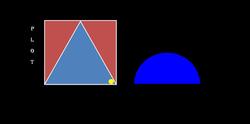Funny yet complicated!!!
 The side of the square(red) is named plot.The side of the square is equal to that of the triangle's base.The base of the triangle is again equal to that of the semicircle.Find one of the angles of triangle marked yellow,if the area of the triangle is equal to that of the semi-circle. Note: The perpendicular to the base of the triangle cuts the base in half.
The side of the square(red) is named plot.The side of the square is equal to that of the triangle's base.The base of the triangle is again equal to that of the semicircle.Find one of the angles of triangle marked yellow,if the area of the triangle is equal to that of the semi-circle. Note: The perpendicular to the base of the triangle cuts the base in half.
This section requires Javascript.
You are seeing this because something didn't load right. We suggest you, (a) try
refreshing the page, (b) enabling javascript if it is disabled on your browser and,
finally, (c)
loading the
non-javascript version of this page
. We're sorry about the hassle.
A/Q the side of the square is equal to the base of the triangle.Now,let take the base as x.Then the base of the semi-circle is also x.Again,consider the angle marked in yellow as y.Then, draw a line perpendicular to the base and the angle.This give us the height.Also,the base is halved.Now,we can use trigonometry.Since,the angle is y and and line below it is x/2.Therefore,the height is x/2 tan y. And the area is x^2/4 tan y.Again,the base of the semicircle is x.Since,it is also it's diameter,therefore,the radius is x/2.Hence the area is x^2/8 pi.A/Q,these two areas are equal.So,x^2/4 tan y =x^2/8 pi.Therefore,tan y=pi/2.Hence,y=57.5.